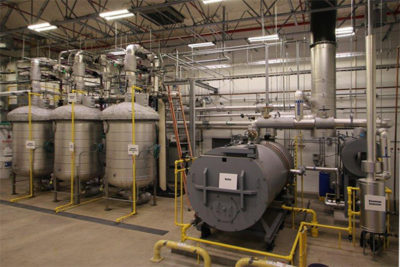Project highlights and product features
- Full-scale application designed to treat groundwater from a large footprint remediation project
- System treats a mixture of groundwater extracted from source area and edge of plume wells with high concentrations and high variability of 1,4-dioxane, other chlorinated constituents and dissolved iron
- Zero-headspace design proved a key feature for iron management, eliminating the need for iron treatment; POTW benefited from dissolved iron pass through to support phosphorous management
- System was designed for remote monitoring and control with limited operator oversight
- ECT2 was engaged to provide a turnkey installation, including building, process equipment and infrastructure
- System supported property divestiture and used a small footprint in a remote section of the property
- System was placed in service in November 2014, and operates at nearly 100% uptime with treated effluent ND at 0.04 ppb for 1,4-dioxane and ND at 1 ppb for TVOC
Treats up to 175 GPM of groundwater
 ECT2 designed and installed a full-scale synthetic media system to treat 1,4-dioxane, other miscible compounds and VOCs from groundwater produced as part of long-term groundwater pump and treat remediation in St. Petersburg, Florida. The system was designed to treat up to 175 gpm of groundwater from wells located in and around residual contamination in the source area and extended plume.
ECT2 designed and installed a full-scale synthetic media system to treat 1,4-dioxane, other miscible compounds and VOCs from groundwater produced as part of long-term groundwater pump and treat remediation in St. Petersburg, Florida. The system was designed to treat up to 175 gpm of groundwater from wells located in and around residual contamination in the source area and extended plume.
The groundwater was originally treated to control iron residuals and fouling prior to removing VOCs and 1,4-dioxane. During the system’s early operation, ECT2 found that the iron removal step was not necessary for media protection, due to the inert properties of the media and zero headspace design of the treatment system. The Municipal Authority allowed dissolved iron levels to be discharged directly, due to beneficial phosphorous reduction in the publicly owned treatment works (POTW). Other benefits of bypassing the iron pretreatment have included increased filter run times, appreciably reduced iron sludge generation and reduced O&M costs. There have been no adverse side effects associated with this approach.
Synthetic media treatment was selected for this application for a number of reasons: (1) many of the miscible compounds would not have been amenable to air stripping, and stripper iron fouling would have been difficult to manage; (2) the complexity and energy required for oxidation would have been prohibitive; (3) advanced oxidation processes proved ineffective for achieving low-level discharge, given the complex groundwater geochemistry, elevated iron levels and the need for stringent discharge control.
More effective than granular activated carbon
This project is another full-scale application of AMBERSORBTM 560 (AMBERSORB), a carbonaceous adsorbent manufactured by The Dow Chemical Company. Its hydrophobicity and unique pore size distribution render it substantially more effective than granular activated carbon. This is especially true for adsorbing highly miscible compounds, such as 1,4-dioxane. AMBERSORB has been used for decades as a specialized sorbent for multiple applications. AMBERSORB was introduced by Dow in 2012 as an alternative treatment technology for addressing the specific challenges of treating 1,4-dioxane.
The system has operated with an uptime greater than 99% since startup in 2014. Influent 1,4-dioxane concentrations ranged from 80 to 240 µg/l. Effluent concentrations since startup are reliably non-detect for 1,4-dioxane and TVOCs alike, with a four-to-five order of magnitude destruction removal efficiency.
The project team applied a number of valuable lessons from other applications of synthetic media for treating 1,4-dioxane, incorporating key findings into the full-scale design. The system was designed with a substantial operating safety factor to assure capacity was sufficient for the unknown and variable conditions experienced on remediation sites. Operator training and process protocols have been standardized to focus on key performance indicators, assuring tight control and early recognition of undesired process variability.
ECT2 has a small, dedicated core synthetic media team organized to manage communication and execution. This has proven essential to providing successful turnkey design/fabrication/startup solutions.